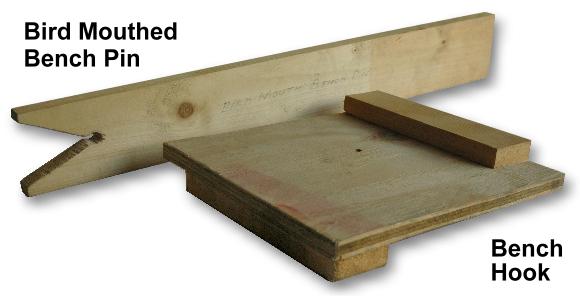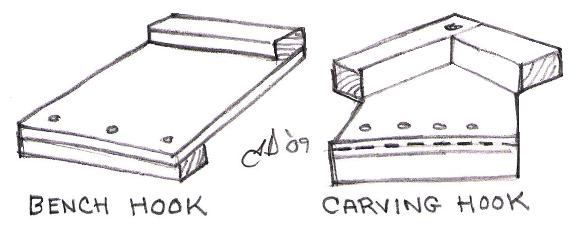Bench Hooks and Pins:
Workbench accessory tools for craftsfolk
So, what are woodworking bench tools doing with blacksmithing information?
Because blacksmiths and other crafts people often work in mixed media (wood and metal).
Besides tools (bellows, fixtures, handles) they often make tool totes, do wagon restoration work, build book shelves, tables AND their own benches.
Those not trained in classical woodworking are often not exposed to these simple to make and handy tools.
 Bench Hooks
Bench Hooks are a simple tool made of three or more pieces of wood.
They are used for sawing, carving or any job where the work needs to be prevented from sliding.
In many cases a bench hook can replace an expensive vise and is quicker to change positions than in a vise.
Bench hooks vary in size from about as big as one's hand to several feet square.
The most common size are about 8" x 12" (20 x 30 cm).
In use a bench hook hangs over the front of the bench or table so that the bottom cleat catches against the edge of the bench.
The work is held against the back cleat or cleats.
The edge of the cleat may be a guide for sawing.
A bench hook can also be used on a drill press for drilling a specific distance from the edge of a board.
Bench hooks can be made of scraps of plywood, softwood, fine hardwood, metal or any combination of materials.
I've made benchhooks in a few minutes from scrap construction grade plywood that served their purpose well.
The important part of their construction is strength, both glue and dowels or glue and nails or screws should be used.
For sawing hooks the cleats need to be cut very square as they are also the blade guide.

Above are two simple bench hooks of the most basic type.
Carving hooks can vary greatly from being squared, V'd, or posts and wedges to support odd shaped work.

The sawing hook above is both left and right handed.
The short cleat is a saw guide and prevents cutting into the bench.
It is used to brace the work and guide the cut when making square cuts with a "back saw" or miter saw.
The groove lets the saw drop through the work and is also a visual guide.
This is the type of bench hook a woodworker might make of good hardwood, put a fine finish on it and paint the bottom of the guide groove.
To support long slender pieces a second matching hook of the same length and thickness may be used.
These are often narrow and do not have the short cleat or groove.

The above are possible carving hook designs for holding odd shaped work.
They could vary in size from as big as one's hand to several feet square.
Bench Pin, or Bird Mouth Bench Pin

 The Bench Pin
The Bench Pin is used for piercing with a jeweler's saw or scroll saw and finishing the same with small files.
Large versions are built into low work benches called saw benches and used for heavy sawing.
The narrow V supports thin materials and small pieces that would be hard to support otherwise.
Over the years I've made a dozen of these and misplaced them as easily as they were made.
They can be made in a few minutes from a piece of 3/4" pine and clamped down using a C-clamp or bench dog.
Commercial bench pins such as the one drawn on the right above are made of hardwood like maple and often have a built-in clamp.
The bottom is generally tapered to make it thinner for working in close spaces.
Bench Pins can also have a cleat on them to clamp in a vise.
Fig 14. iForge Spatula
References and Links





Bench Hooks and Pins:
Workbench accessory tools for craftsfolk
So, what are woodworking bench tools doing with blacksmithing information? Because blacksmiths and other crafts people often work in mixed media (wood and metal). Besides tools (bellows, fixtures, handles) they often make tool totes, do wagon restoration work, build book shelves, tables AND their own benches. Those not trained in classical woodworking are often not exposed to these simple to make and handy tools.Bench Hooks are a simple tool made of three or more pieces of wood. They are used for sawing, carving or any job where the work needs to be prevented from sliding. In many cases a bench hook can replace an expensive vise and is quicker to change positions than in a vise. Bench hooks vary in size from about as big as one's hand to several feet square. The most common size are about 8" x 12" (20 x 30 cm).
In use a bench hook hangs over the front of the bench or table so that the bottom cleat catches against the edge of the bench. The work is held against the back cleat or cleats. The edge of the cleat may be a guide for sawing. A bench hook can also be used on a drill press for drilling a specific distance from the edge of a board.
Bench hooks can be made of scraps of plywood, softwood, fine hardwood, metal or any combination of materials. I've made benchhooks in a few minutes from scrap construction grade plywood that served their purpose well. The important part of their construction is strength, both glue and dowels or glue and nails or screws should be used. For sawing hooks the cleats need to be cut very square as they are also the blade guide.
Above are two simple bench hooks of the most basic type. Carving hooks can vary greatly from being squared, V'd, or posts and wedges to support odd shaped work.
The sawing hook above is both left and right handed. The short cleat is a saw guide and prevents cutting into the bench. It is used to brace the work and guide the cut when making square cuts with a "back saw" or miter saw. The groove lets the saw drop through the work and is also a visual guide. This is the type of bench hook a woodworker might make of good hardwood, put a fine finish on it and paint the bottom of the guide groove. To support long slender pieces a second matching hook of the same length and thickness may be used. These are often narrow and do not have the short cleat or groove.
The above are possible carving hook designs for holding odd shaped work. They could vary in size from as big as one's hand to several feet square.
Bench Pin, or Bird Mouth Bench Pin
Bench Pins can also have a cleat on them to clamp in a vise.
Fig 14. iForge Spatula
References and Links